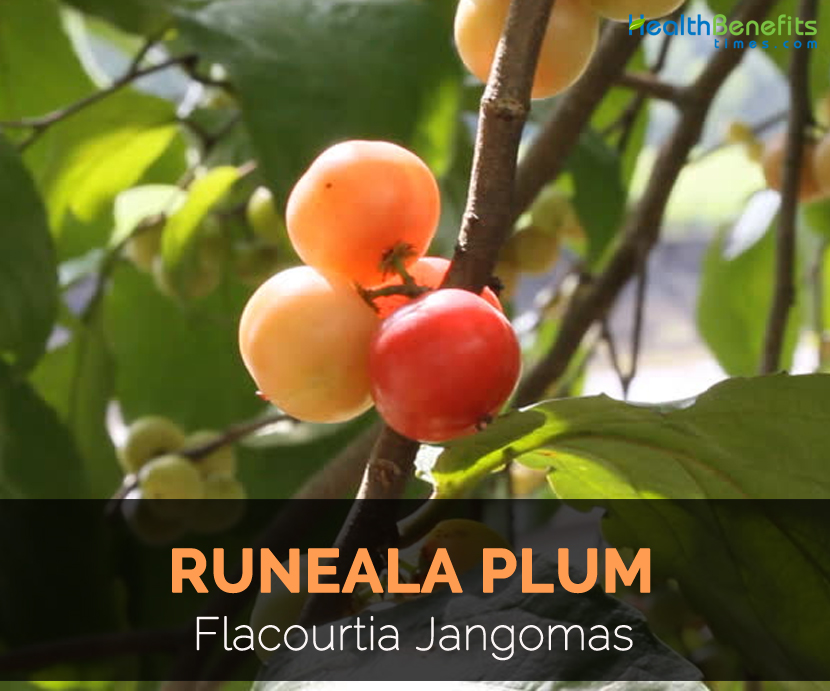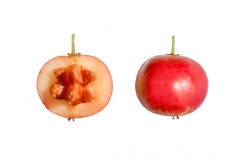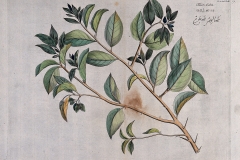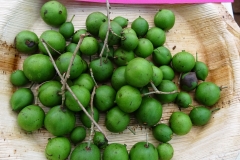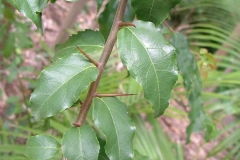| Runeala Plum Quick Facts |
| Name: |
Runeala Plum |
| Scientific Name: |
Flacourtia Jangomas |
| Origin |
Native to Bangladesh, India and Myanmar |
| Colors |
Dull-brownish red or purple |
| Shapes |
Subglobose 1.7–2.5 cm across |
| Flesh colors |
Firm, brownish green |
| Taste |
Acid to sweet |
Runeala plum is the species which is cultivated around villages and naturalized throughout tropical regions especially in East Africa and tropical Asia. It is naturalized in primary and secondary rainforest up to 1500 m altitude. It is commonly found in Southeast Asia, Southern China, Eastern Malaya and also in Philippines. It prefers well-drained fertile soils and full sun. It is sensitive to frost. Flacourtia Jangomas is inherent to African and Asian tropics and subtropics. It is well known among Caribbean as locals utilize the fruits in dishes and drinks.
Runeala plum, Flacourtia jangomas, is a lowland and mountain rain forest tree which belongs to family Salicaceae or Willow. The tree is common in Southern India and has immense culinary and medical significance especially in Kerala where it is known as lovlolika or lubica. Fruits are consumed both raw and cooked. The bark is also used for medicinal purposes. It is also harvested for its lumber. It is regarded to be the fundamental host plants of Queensland fruit fly. Flowers bloom from December to April together with new leaves with fresh green color.
Plant description
Runeala plum is a large, erect and deciduous shrub to small tree which reaches 5 to 10 meters high. The older branches and trunk are unarmed, young branches are lenticellate or spiny with simple/divaricate spines. Bark is flaky, light brown to reddish brown. Leaves are alternate, narrow-ovate, ovate elliptic to ovate-oblong about 7-12 cm by 2.5-5 cm. The apex is tapering to narrowly acuminate with cuneate to rounded base, entire margins, sinuate to sub-serrate to crenate, glabrous and shiny above and dull below. Juvenile leaves are pinkish to reddish-brown. Flowers are white to greenish and honey scented on slender pedicles about 1 to 1.5 cm. Sepals is ovate-obtuse, sparingly pubescent and greenish. Flowers (male) are glabrous and stamens with 2 to 3 mm filaments. Flowers (female) is flask shaped to sub-globose ovary which is 2 to 3 mm across having 4 to 6 styles in a connate, distinct column and slightly free at apices with reniform, dilated and recurved stigma. Fruits are sub-globose, pale green to dull brownish red or purple, about 1.7 to 2.5 cm across. The fruit pulp is greenish to yellow, acid-sweet that encloses hard, flat and pale yellow seeds.
Stems and Leaves
Branches and trunks are thornless when old and are densely armed with simple/branched woody thorns when it is younger. Bark varies in color from light brown or grey to copper-red or pinkish-buff in color and flakes off in thin scales. Leaves are narrowly egg shaped to oblong and have pointed tips. Leaves are hairless, toothed, 5-11 cm long and 2-5.5 cm wide. Upper surfaces are glossy and undersides appear to be dull. Leaves form on shortstalk measuring 6-8 mm long and arranged alternately along the stems.
Flowers and Fruit
Flowers form in few flowered clusters in axillary racemes. The flowers are fragrant, unisexual and borne on separate plants. It is usually found before or with first leaves in spring. The clusters of male flower are 5 to 30 mm long comprising few rounded flowers forming on slender stalks (about 5 to 15 mm long). Male flower has four tiny greenish sepals usually broad with rounded tips. Female flowers are 10 to 15 mm long that consists of few flowers having similar sepals to male flowers. Flowers are followed by round berries usually 15 to 25 mm across. The color turns from green to dull brownish red or dark purple. Fruits have greenish-yellow pulp that contains 4 to 5 flattened seeds which are 10 mm long and 7 mm wide.
Traditional uses
- Fruits are used to cure diarrhea, nausea and biliousness.
- Leaf decoction is useful for treating diarrhea.
- Powdered leaves are used to provide relief from coughs and bronchitis.
- Apply the bark and leaves on aching teeth and bleeding gums.
- Gargle with bark infusion in order to alleviate hoarseness.
- Use the roots poultice on sores and skin eruptions or in mouth to soothe toothache.
- Leaves decoction are used for treating dysentery, diarrhea and piles.
- Fruits are used to overcome digestive problems, fevers, biliousness and nausea.
- Dried leaves are used for treating asthma in India.
- In Malaysia, leaf decoction is used to cure diarrhea, promote digestion and roots juice is helpful for herpes infection.
- Apply the root paste to ulcers, sores and soothe inflamed throat.
- Fruits are used to treat jaundice and enlarged spleen.
- Fruits are also used to treat liver associated problems.
- In South Indian traditional medicine, the plant is used for health ailments such as skin disease, inflammation, diarrhea, tumors, jaundice, diabetes, nausea and dyspepsia.
- To prevent rheumatic pains after child birth, grind the seeds into powder with turmeric and rub it all over the body.
Culinary uses
- Fruits are consumed as dessert or made into juice, marmalade, jam, syrup, sauces and pickles.
- Under ripe fruits are used for making jellies.
- In Indonesia, young shoots are consumed.
- Leaves and young shoots resemble the taste of rhubarb.
References:
https://www.itis.gov/servlet/SingleRpt/SingleRpt?search_topic=TSN&search_value=506135#null
https://www.researchgate.net/publication/323534507_Ethnomedicinal_Phytochemical_and_Pharmacological_Aspects_of_Flacourtia_jangomas_A_Review
https://keyserver.lucidcentral.org/weeds/data/media/Html/flacourtia_jangomas.pdf
Comments
comments


